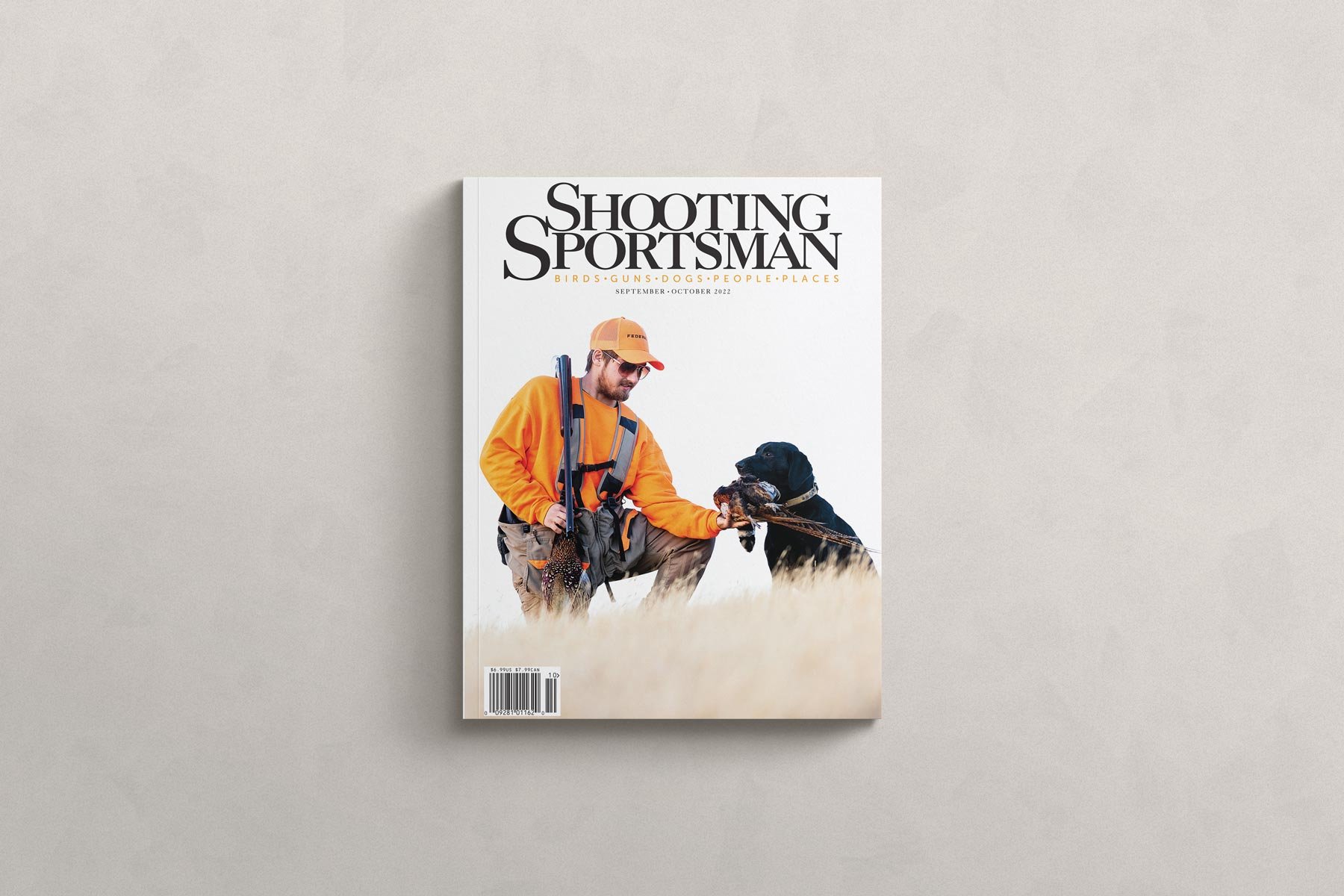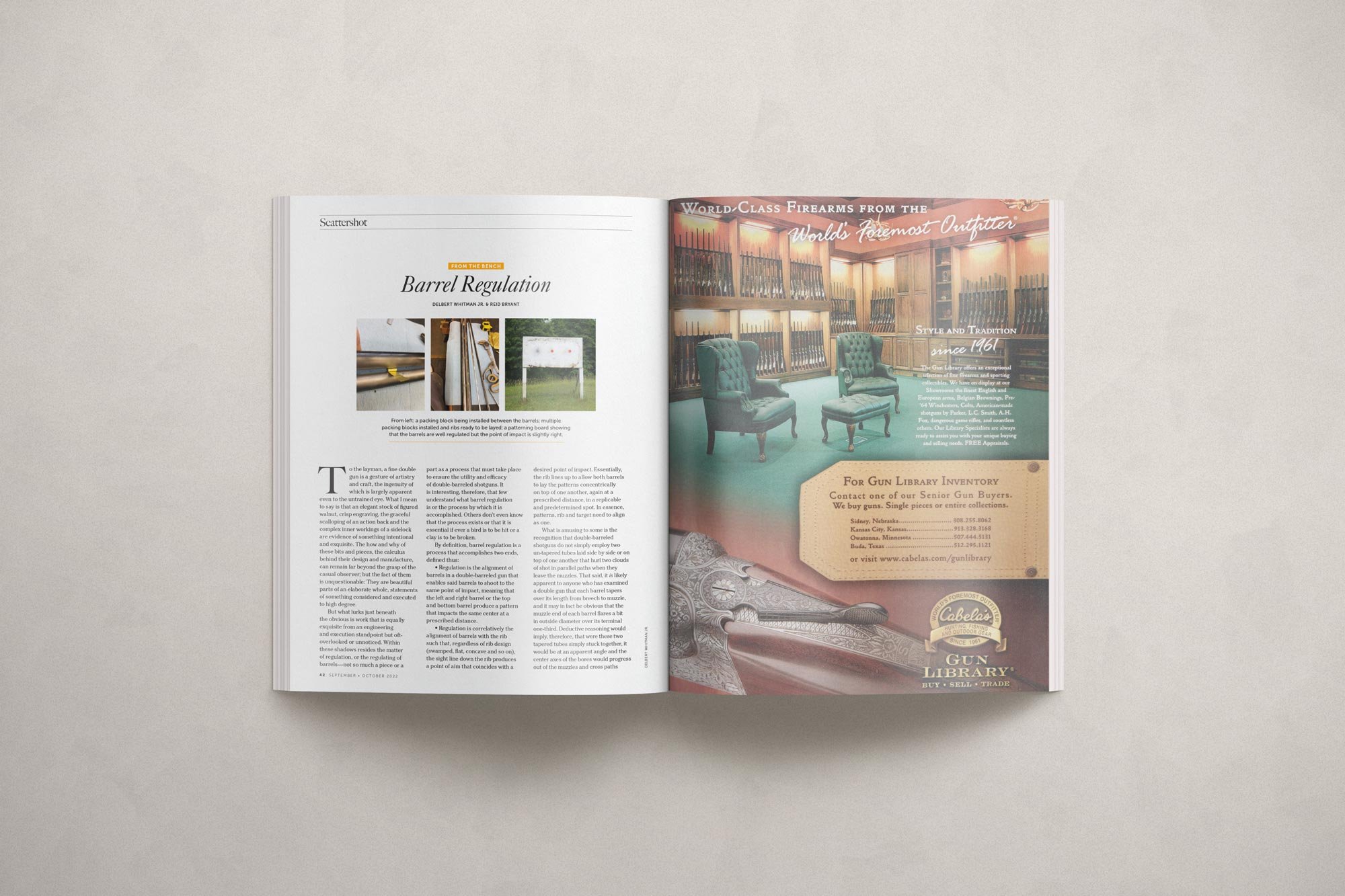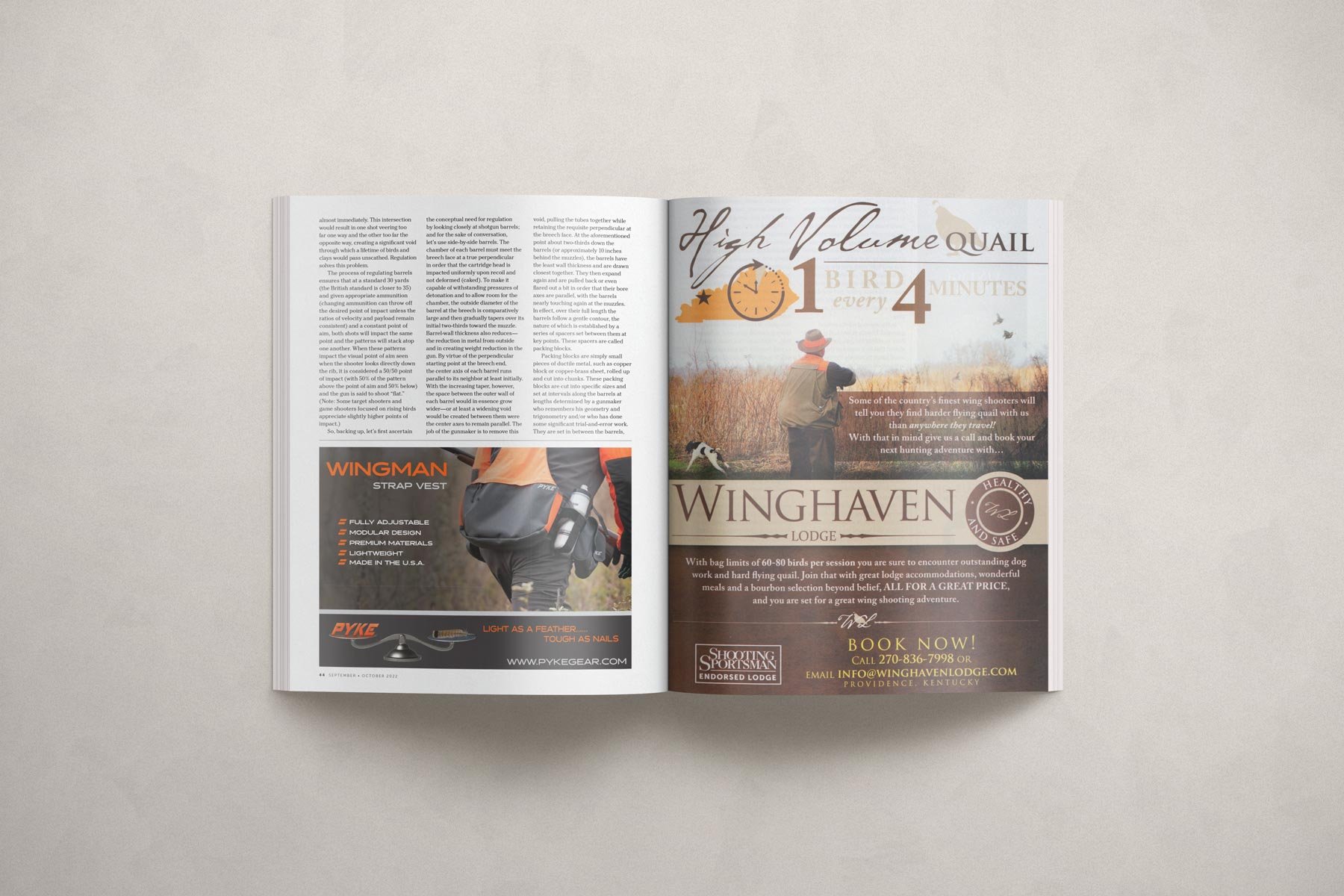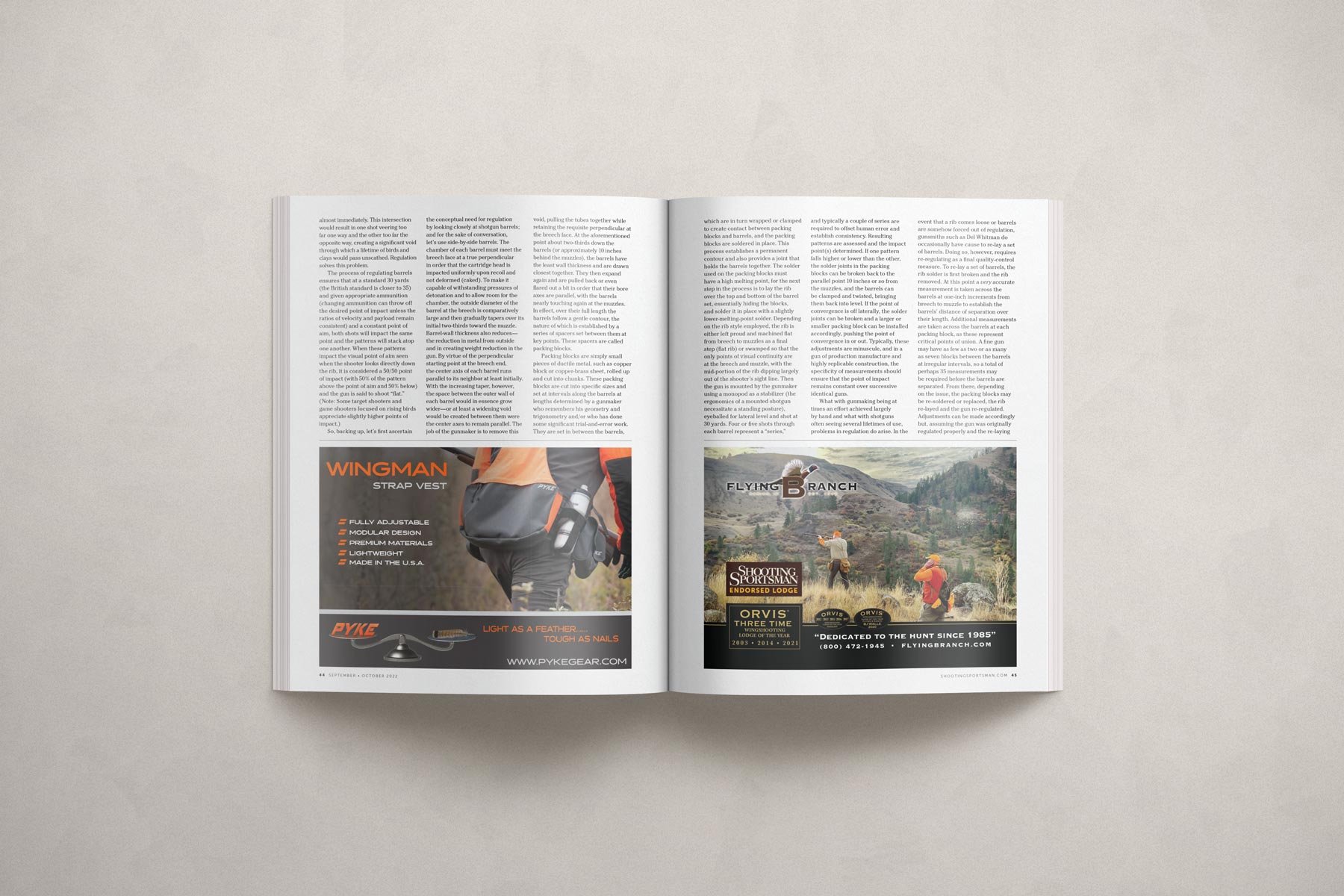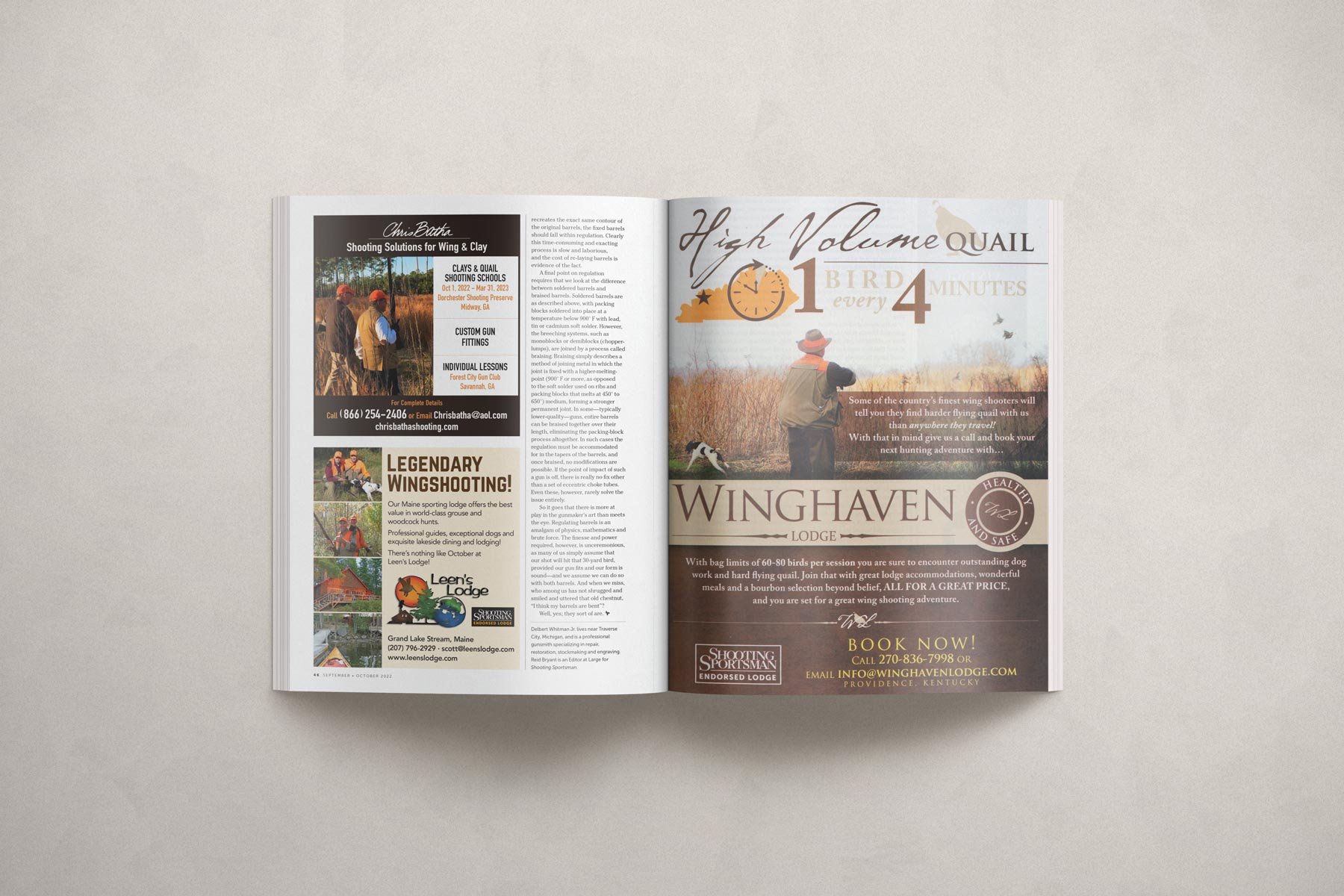Barrel Regulation
To the layman, a fine double gun is a gesture of artistry and craft, the ingenuity of which is largely apparent even to the untrained eye. What I mean to say is that an elegant stock of figured walnut, crisp engraving, the graceful scalloping of an action back and the complex inner workings of a sidelock are evidence of something intentional and exquisite. The how and why of these bits and pieces, the calculus behind their design and manufacture, can remain far beyond the grasp of the casual observer; but the fact of them is unquestionable: They are beautiful parts of an elaborate whole, statements of something considered and executed to high degree.
But what lurks just beneath the obvious is work that is equally exquisite from an engineering and execution standpoint but oft-overlooked or unnoticed. Within these shadows resides the matter of regulation, or the regulating of barrels—not so much a piece or a part as a process that must take place to ensure the utility and efficacy of double-barreled shotguns. It is interesting, therefore, that few understand what barrel regulation is or the process by which it is accomplished. Others don’t even know that the process exists or that it is essential if ever a bird is to be hit or a clay is to be broken.
By definition, barrel regulation is a process that accomplishes two ends, defined thus:
• Regulation is the alignment of barrels in a double-barreled gun that enables said barrels to shoot to the same point of impact, meaning that the left and right barrel or the top and bottom barrel produce a pattern that impacts the same center at a prescribed distance.
• Regulation is correlatively the alignment of barrels with the rib such that, regardless of rib design (swamped, flat, concave and so on), the sight line down the rib produces a point of aim that coincides with a desired point of impact. Essentially, the rib lines up to allow both barrels to lay the patterns concentrically on top of one another, again at a prescribed distance, in a replicable and predetermined spot. In essence, patterns, rib and target need to align as one.
What is amusing to some is the recognition that double-barreled shotguns do not simply employ two un-tapered tubes laid side by side or on top of one another that hurl two clouds of shot in parallel paths when they leave the muzzles. That said, it is likely apparent to anyone who has examined a double gun that each barrel tapers over its length from breech to muzzle, and it may in fact be obvious that the muzzle end of each barrel flares a bit in outside diameter over its terminal one-third. Deductive reasoning would imply, therefore, that were these two tapered tubes simply stuck together, it would be at an apparent angle and the center axes of the bores would progress out of the muzzles and cross paths almost immediately. This intersection would result in one shot veering too far one way and the other too far the opposite way, creating a significant void through which a lifetime of birds and clays would pass unscathed. Regulation solves this problem.
The process of regulating barrels ensures that at a standard 30 yards (the British standard is closer to 35) and given appropriate ammunition (changing ammunition can throw off the desired point of impact unless the ratios of velocity and payload remain consistent) and a constant point of aim, both shots will impact the same point and the patterns will stack atop one another. When these patterns impact the visual point of aim seen when the shooter looks directly down the rib, it is considered a 50/50 point of impact (with 50% of the pattern above the point of aim and 50% below) and the gun is said to shoot “flat.” (Note: Some target shooters and game shooters focused on rising birds appreciate slightly higher points of impact.)
So, backing up, let’s first ascertain the conceptual need for regulation by looking closely at shotgun barrels; and for the sake of conversation, let’s use side-by-side barrels. The chamber of each barrel must meet the breech face at a true perpendicular in order that the cartridge head is impacted uniformly upon recoil and not deformed (caked). To make it capable of withstanding pressures of detonation and to allow room for the chamber, the outside diameter of the barrel at the breech is comparatively large and then gradually tapers over its initial two-thirds toward the muzzle. Barrel-wall thickness also reduces—the reduction in metal from outside and in creating weight reduction in the gun. By virtue of the perpendicular starting point at the breech end, the center axis of each barrel runs parallel to its neighbor at least initially. With the increasing taper, however, the space between the outer wall of each barrel would in essence grow wider—or at least a widening void would be created between them were the center axes to remain parallel. The job of the gunmaker is to remove this void, pulling the tubes together while retaining the requisite perpendicular at the breech face. At the aforementioned point about two-thirds down the barrels (or approximately 10 inches behind the muzzles), the barrels have the least wall thickness and are drawn closest together. They then expand again and are pulled back or even flared out a bit in order that their bore axes are parallel, with the barrels dearly touching again at the muzzles. In effect, over their full length the barrels follow a gentle contour, the nature of which is established by a series of spacers set between them at key points. These spacers are called packing blocks.
Packing blocks are simply small pieces of ductile metal, such as copper block or copper-brass sheet, rolled up and cut into chunks. These packing blocks are cut into specific sizes and set at intervals along the barrels at lengths determined by a gunmaker who remembers his geometry and trigonometry and/or who has done some significant trial-and-error work. They are set in between the barrels, which are in turn wrapped or clamped to create contact between packing blocks and barrels, and the packing blocks are soldered in place. This process establishes a permanent contour and also provides a joint that holds the barrels together. The solder used on the packing blocks must have a high melting point, for the next step in the process is to lay the rib over the top and bottom of the barrel set, essentially hiding the blocks, and solder it in place with a slightly lower-melting-point solder. Depending on the rib style employed, the rib is either left proud and machined flat from breech to muzzles as a final step (flat rib) or swamped so that the only points of visual continuity are at the breech and muzzle, with the mid-portion of the rib dipping largely out of the shooter’s sight line. Then the gun is mounted by the gunmaker using a monopod as a stabilizer (the ergonomics of a mounted shotgun necessitate a standing posture), eyeballed for lateral level and shot at 30 yards. 4-5 shots through each barrel represent a “series”, and typically a couple of series are required to offset human error and establish consistency. Resulting patterns are assessed and the impact point(s) determined. If one pattern falls higher or lower than the other, the solder joints in the packing blocks can be broken back to the parallel point 10” or so from the muzzles, and the barrels can be clamped and twisted, bringing them back into level. If the point of convergence is off laterally, the solder joints can be broken and a larger or smaller packing block can be installed accordingly, pushing the point of convergence in or out. Typically, these adjustments are minuscule, and in a gun of production manufacture and highly replicable construction, the specificity of measurements should ensure that the point of impact remains constant over successive identical guns.
What with gunmaking being at times an effort achieved largely by hand and what with shotguns often seeing several lifetimes of use, problems in regulation do arise. In the event that a rib comes loose or barrels are somehow forced out of regulation, gunsmiths such as Del Whitman do occasionally have cause to re-lay a set of barrels. Doing so, however, requires re-regulating as a final quality-control measure. To re-lay a set of barrels, the rib solder is first broken and the rib removed. At this point a very accurate measurement is taken across the barrels at 1” increments from breech to muzzle to establish the barrels’ distance of separation over their length. Additional measurements are taken across the barrels at each packing block, as these represent critical points of union. A fine gun may have as few as two or as many as seven blocks between the barrels at irregular intervals, so a total of perhaps 35 measurements may be required before the barrels are separated. From there, depending on the issue, the packing blocks may be re-soldered or replaced, the rib re-layed and the gun re-regulated. Adjustments can be made accordingly but, assuming the gun was originally regulated properly and the re-laying recreates the exact same contour of the original barrels, the fixed barrels should fall within regulation. Clearly this time-consuming and exacting process is slow and laborious, and the cost of re-laying barrels is evidence of the fact.
A final point on regulation requires that we look at the difference between soldered barrels and braised barrels. Soldered barrels are as described above, with packing blocks soldered into place at a temperature below 900° F with lead, tin or cadmium soft solder. However, the breeching systems, such as monoblocks or demiblocks (chopper-lumps), are joined by a process called braising. Braising simply describes a method of joining metal in which the joint is fixed with a higher-melting-point (900° F or more, as opposed to the soft solder used on ribs and packing blocks which melts at 450-650 degrees) medium, forming a stronger permanent joint. In some—typically lower-quality—guns, entire barrels can be braised together over their length, eliminating the packing-block process altogether. In such cases the regulation must be accommodated for in the tapers of the barrels, and once braised, no modifications are possible. If the point of impact of such a gun is off, there is really no fix other than a set of eccentric choke tubes. Even these, however, rarely solve the issue entirely. Permanently boring fixed chokes for eccentricity can be done with front-inserted reamers, but the potential for permanently damaging the choke section of the barrels, and effectively rendering them unfixable, is good reason to tread lightly. A good after-market eccentric screw-in installed by a specialist such as Briley is the safest fix.
So it goes that there is more at play in the gunmaker’s art than meets the eye. Regulating barrels is an amalgam of physics, mathematics and brute force. The finesse and power required, however, is unceremonious, as many of us simply assume that our shot will hit that 30-yard bird, provided our gun fits and our form is sound—and we assume we can do so with both barrels. And when we miss, who among us has not shrugged and smiled and uttered that old chestnut, “I think my barrels are bent”?
Well, yes; they sort of are.
First Published in Shooting Sportsman
